Qualcomm Demos Snapdragon 805 & 802 at CES 2014
by Anand Lal Shimpi on January 14, 2014 6:25 PM EST- Posted in
- Trade Shows
- Qualcomm
- SoCs
- Snapdragon 805
- CES 2014
- Snapdragon 802
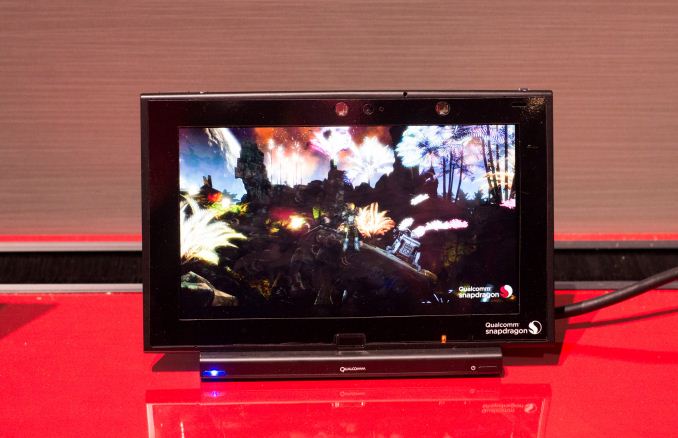
I don't know of any other mobile SoC vendor (outside of Apple) that has been able to deliver frequent, consistent architecture and product updates as well as Qualcomm. Its latest Snapdragon SoCs remain the ones to beat across all Android smartphones, and are generally found in many of the more desirable Android tablets. Last year we saw the announcement of Qualcomm's Snapdragon 805 that combines four Krait 450 CPU cores with a brand new Adreno 420 GPU, all behind a 128-bit wide memory interface. It's a pretty significant step forward at the SoC level, but particularly when it boils down to graphics. Qualcomm is promising a 40% increase in shader bound workloads compared to Adreno 330, which is pretty impressive given that we're still talking about a 28nm HPM design.
With a GPU heavy focus, Qualcomm was more than eager to show off a bunch of games running on Snapdragon 805 tablets at the show. These tablets were all running at 2560 x 1600 and had no issues delivering smooth, playable frame rates regardless of the content.
With Adreno 420 Qualcomm adds hardware tessellation, and of course had a tessellation demo at the show:
Demonstrating the additional GPU overhead offered by Adreno 420 over Adreno 330, Qualcomm had a GPU utilization monitor up on one of the systems. This test allegedly had Adreno 330 utilization at close to 100%, compared to sub-60% on Adreno 420.
Qualcomm also had Unreal Engine 3 and Unity demos, demonstrating that the company has been working closely with top tier engine providers. I fully expect the mobile GPU wars to heat up this year with Adreno 4xx from Qualcomm, mobile Kepler from NVIDIA and Apple likely moving more aggressively after the milder than expected GPU update in the A7.
Snapdragon 805 is also the first Qualcomm SoC to integrate HQV's video processing IP post acquisition, which Qualcomm promptly showed off at the show with a sequence of 1080p video upscaled to 4K. Even on the reference tablet's 2560 x 1600 resolution there's a decent quality improvement:
Good quality scaling hardware is very important, especially as tablets move to ultra high resolutions while most mobile content remains at 1080p.
Although it didn't announce any new mobile SoCs at CES last week, Qualcomm did introduce new automotive and TV SoCs: Snapdragon 602A and 802, respectively. The latter is a variant of Snapdragon 800, intended for use in TVs. Qualcomm had a reference board up and running showing off a 4K TV with a native resolution UI, driven by the SoC's Adreno 330 GPU. Qualcomm even had Riptide running, at 4K, all off of the adapted mobile SoC.
There are many believers (including NVIDIA's Jen-Hsun Huang) in the view that automotive applications of high performance mobile SoCs will be huge. You could make the same argument for high performance mobile SoCs in TVs as well. Traditionally, large amounts of user facing compute power have been kept out of both of those applications. Should that tradition stop now, the current day leaders in mobile will likely have a big advantage in entering those markets. Just as we saw in mobile however, I suspect a big part of compute being useful in cars and TVs will depend on having the right software to properly take advantage of the hardware.


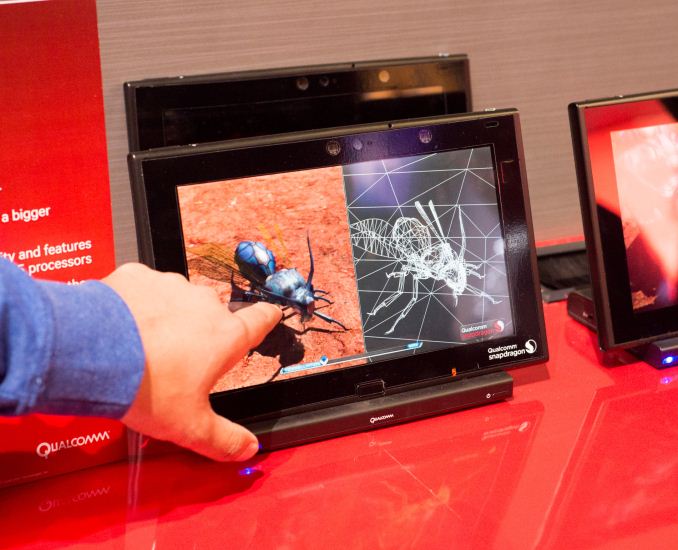
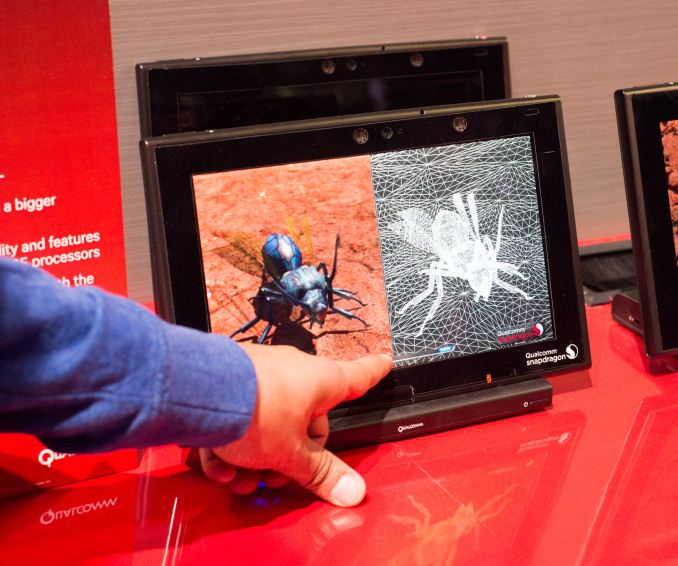
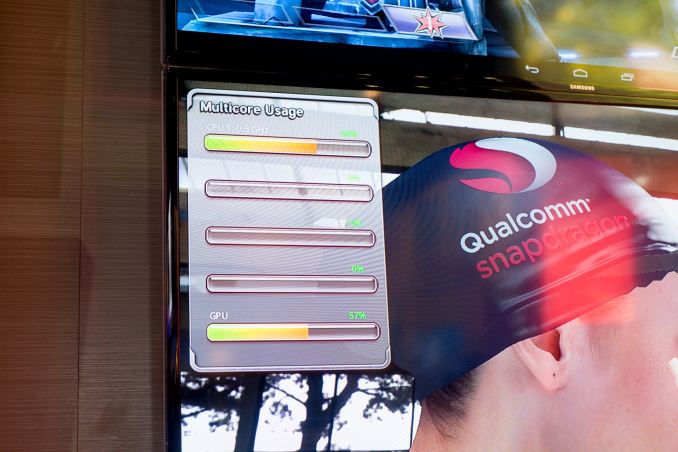
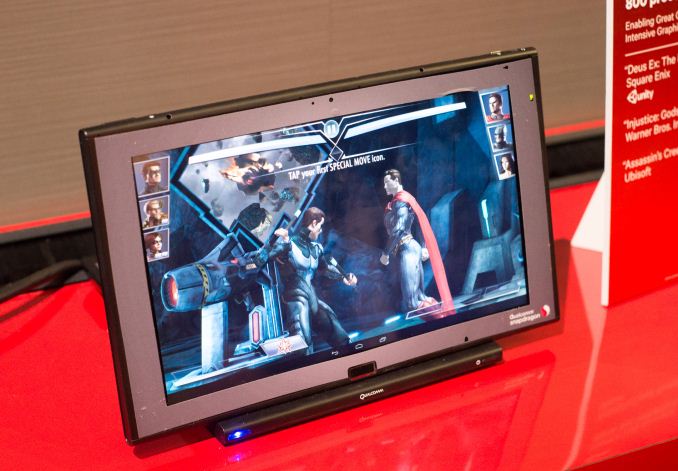


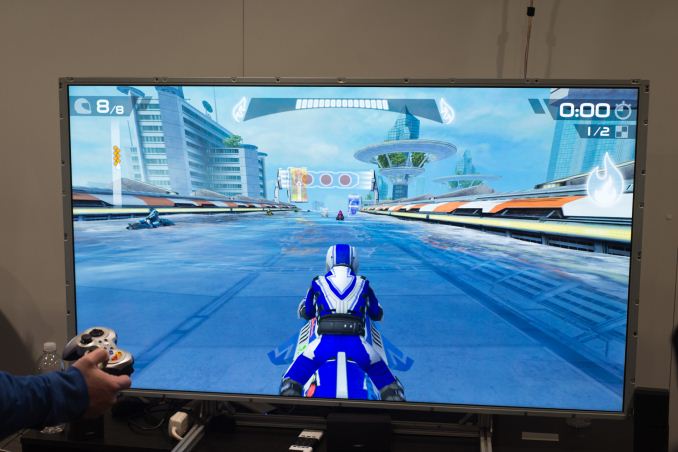












26 Comments
View All Comments
neoraiden - Tuesday, January 14, 2014 - link
How does this compare to Nvidia's new K1(roughly based on the figures quoted)? Right now I'm getting the feeling that nvidia's only significant advantage is in it's ability to port games due to it's scaled down desktop tech.Loki726 - Tuesday, January 14, 2014 - link
If you believe the 40% improvement for 805, it puts 805 and K1 roughly neck and neck. We'll have to wait for devices to start shipping to know for sure.nathanddrews - Tuesday, January 14, 2014 - link
Take with a grain of salt, but check out the K1 performance on a native 4K tablet:http://www.tomshardware.com/news/lenovo-thinkvisio...
Poik - Tuesday, January 14, 2014 - link
In theory K1 would have that advantage but it would likely only be a real advantage with Windows as Android would use different API's than used by Windows/most of Nvidia's desktop tech. It will be interesting to see how things settle in the coming months and who gets the design win. It sounded like in other releases Qualcomm was wanting to hold their cards tighter than they had previously. If Samsung is going 64-bit Exynos for the S5 then it would make sense for the North American version to be 64-bit as well which means K1 could be in the running tho a mere "Dual Core" might be a no go for Samsung. I can see Qualcomm really wanting to get their 810 out by then and making for an impressive launch. Otherwise an 805 might make for at least a competitive replacement but makes for a less impressive only kind of 64 bit launch.MikhailT - Tuesday, January 14, 2014 - link
> Apple likely moving more aggressively after the milder than expected GPU update in the A7.How can Apple move more aggressively if they're still dependent on what ImagTech does. Considering the Series 6XT refresh being a quicker version (rumored to be 50% faster) of the same Series 6 that iPad already have (it took them two years to increase it by 50% in 6XT), I don't think Apple will beat either K1 or Qualcomm's Adreno GPUs this year.
toukale - Tuesday, January 14, 2014 - link
Someone have not been paying attention. Apple have been hiring gpu engineers for the past two years. Talks are they will bring it in house like they did with their cpu. If that is indeed the case then I will look for apple to bring the heat.MikhailT - Tuesday, January 14, 2014 - link
I missed the news about Apple hiring recently in Orlando for its own GPU designs, now it makes sense and it is going to be interesting.Apple do have a few starting designs that they can work off for now, Series 6 from ImagTech, Mali from ARM or nVidia's GPU as they offer a broad IP licensing program.
Once they hit it off, then the GPU becomes more customized like the evolution of A5>A7 chips.
melgross - Sunday, January 19, 2014 - link
This could even be more interesting. Remember that Apple owns 11% of Imagination, and Intel owns 15%, which they bought right after Apple.Could Apple, and possibly Intel, convince Imagination to give one, or both, an architecture license, allowing them to build their own GPU's, as Apple does now with ARM? That could certainly be a reason why Apple is hiring GPU engineers. Coming out with a GPU from scratch? I'm not so sure Apple would want to try that. It could take years before they could get that right.
name99 - Monday, January 20, 2014 - link
"It could take years before they could get that right."(a) You are assuming that they are starting this today. Who's to say they didn't start it YEARS ago? Maybe the GPU team began its work at the same time as the Swift team, and are just taking a little longer?
(b) You have to look at the big picture. Current Apple does not do things randomly, without a plan. They probably have a SoC plan stretching out ten years. If you were planning for ten years of SoCs, what would you want? Having their own GPU allows them to get their on their schedule.
As I've said before, I expect the A8 to be basically Apple's Sandy Bridge. They'll stick with the A7 core, there'll probably be MHz improvements from a switch to 20nm, but the big work will be adding their own custom GPU along with a Nehalem/Sandy Bridge type architecture, so a ring tying together cores, L3 slices, GPU and memory controller. They *might* add a third core depending on their expectations for how well their high end apps like Aperture and Final Cut (or heck, even iPhoto and iMovie) might use such a core.
Rather less gee whiz, but I expect the M8 will also be a custom Apple core (effectively the companion core for the A8, but with a different philosophy, and essentially SW managed rather than OS or HW managed) and the M8 will live on the same SoC.
mikehunt69 - Wednesday, January 15, 2014 - link
But have they bought any GPU companies. On the CPU side they purchases P.A. Semi.GPU engineers would always been needed by a systems/SCO vendor to optimize and integrate GPUs into their systems, so unless Apple was hiring GPU engineers in large numbers and has been head hunting the big industry talent, you're drawing the wrong conclusions.
As with CPUs, GPUs are iterative designs that are refined over a number of years and even the mighty Apple wouldn't be able to engineer one from scratch, in house (without acquisition) and be able to better the industry leaders, without breaking patents held by others.
Apple owns about 10% of Imgtec, but that wouldn't give them access to the intellectual property and patents.